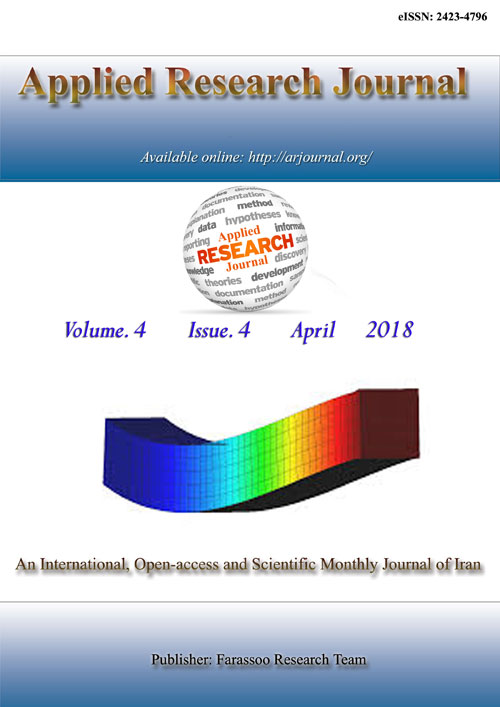فهرست مطالب
Applied Research Journal
Volume:3 Issue: 5, May 2017
- تاریخ انتشار: 1396/02/30
- تعداد عناوین: 4
-
Pages 142-149Upon wetting of the gypseous soils, the apparent cementation by the gypsum is lost gradually leading to the collapse phenomena. Cracking and settlement of buildings are incidents. This paper investigates the effect of the time-based soaking process on the shear strength parameters of the sand soil. The soil samples are from site near the faculty of engineering at the university of Kufa in Al-Najaf, Iraq. The soaking durations on the soil samples are one week, two weeks and four weeks. These samples are tested in the shear box with different normal stress then the results of these samples are compared with result of reference sample (non-soaked sample). The results compared with available reported data and performing a probability analysis of the soaked results. The results show a decreasing in shear strength parameter ( ) with increasing soaking duration. The decreasing ratios are -3.83% and -12.68% related to the reference value (natural) for 2-weeks and 4-weeks respectively. According to probability analysis, the safety index equal to 1.73 for -mean-value equal to after 4weeks soaking (minimum value).Keywords: Sand Soil, Soaking Process, Shear Strength Parameters, Probability, Safety Index
-
Pages 150-159Stochastic evaluation of the minimum thickness requirement of CFRP in built-up timber columns in compression and flexure is presented. It is carried out using the Box complex method for complex constraint problems. The critical load is obtained for pin ended columns made of circular built-up glulam timber which is also externally wrapped with CFRP. The critical load is used to find the constraint equation which is the difference between the critical load and the safe load of glulam for the four strength classes employed. The safe load is obtained from the relevant Eurocode. The constraint equation and critical loads are then considered using the Box method with the critical load as the objective function and variables such as: column diameters, CFRP thicknesses, and lengths of columns. The method is applied by varying one parameter at a time, while leaving the others constant. When CFRP thickness is varied, it is observed that for some increases in the CFRP thicknesses there are increases in the minimum function which is the measure of the strength or capacity of the column. Therefore, it is concluded herein, that increases in CFRP thicknesses are recommended up to an optimum value depending on the lengths or spans in order to strengthen structural members like columns beams, etc., as long as delamination or de-bonding does not occur; and the Box method can be safely used for analysing structural members. Also, it is clear that relevant Euro codes prove to be suitable and convenient design criteria.Keywords: Glulam Timber Columns, Flexure, Compression, CFRP, Optimization, Wrap Thickness
-
Pages 160-166This paper covers using of waste glass bottles to modify the properties of poor subgrade soils. The study involved grinding of waste glass bottles into powder in two categories based on the size of particles: category S1 includes particles between 425µm and 75µm whereas category S2 includes particles finer than 75µm. For both categories, five different contents of glass powder were added to a selected soil to investigate their effects on its engineering properties. The results exhibited that increase in glass powder content increases the strength of subgrade soil and decreases its volume change susceptibility. However, using S2-powder revealed better results than those attained using S1-powder. Compared to unmodified soil, maximum dry density, resilient modulus, and CBR values of soils modified using 20% of S2-glass powder increased to 112%, 394%, and 853% respectively whereas the values of liquid limit, plasticity index, optimum moisture content, and swelling ratio decreased to 85%, 68%, 80% and 51% respectively.Keywords: Subgrade, Properties Modification, Waste Material, Glass Powder, Soil Strength, Swelling Potential
-
Pages 167-178Risk management is one of the modern scientific introductions. Service and productive organizations are equally interested in this domain so as to provide the required administration outcomes, according to the re The research is divided into two essential parts. The first is a presentation of the most important concepts of risk management and how to apply this concept on the Iraqi oil fields projects, using appropriate techniques and appropriate statistical programs (Statistical Analysis, Analytic Hierarchy AHP). Moreover, it presents the most prominent civil works in the oil fields at all levels, starting from digging, extraction and exportation. Oil fields of AAhadab and Badra, located at Wassit province, are chosen as the fields of the study. The researcher focused on collecting the most important risks that the civil works encounter in the field of oil, which were classified according to their nature and analyzed. That is requirements of the productive establishments and the global market. In order for an establishment to continue and develop among the growing contest, it should be able to provide the appropriate requirements for risk management. The purpose of this research is to know the most important risks that the civil works encounter in Iraqi oil fields as well as know their effect on the goals of the project (cost, time and quality). It also specifies its priorities and find out which part is the best for all risks.Keywords: Oilfield in Iraq, Risk Management, Analytical Hierarchy Process (AHP)


